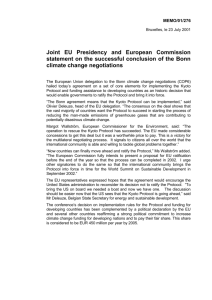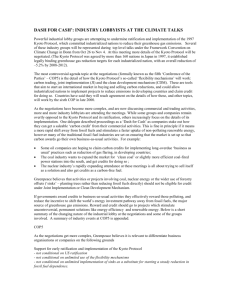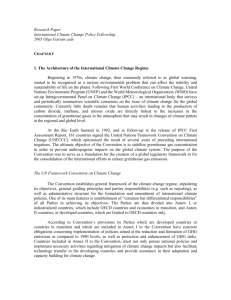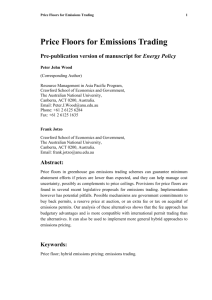DOC
advertisement
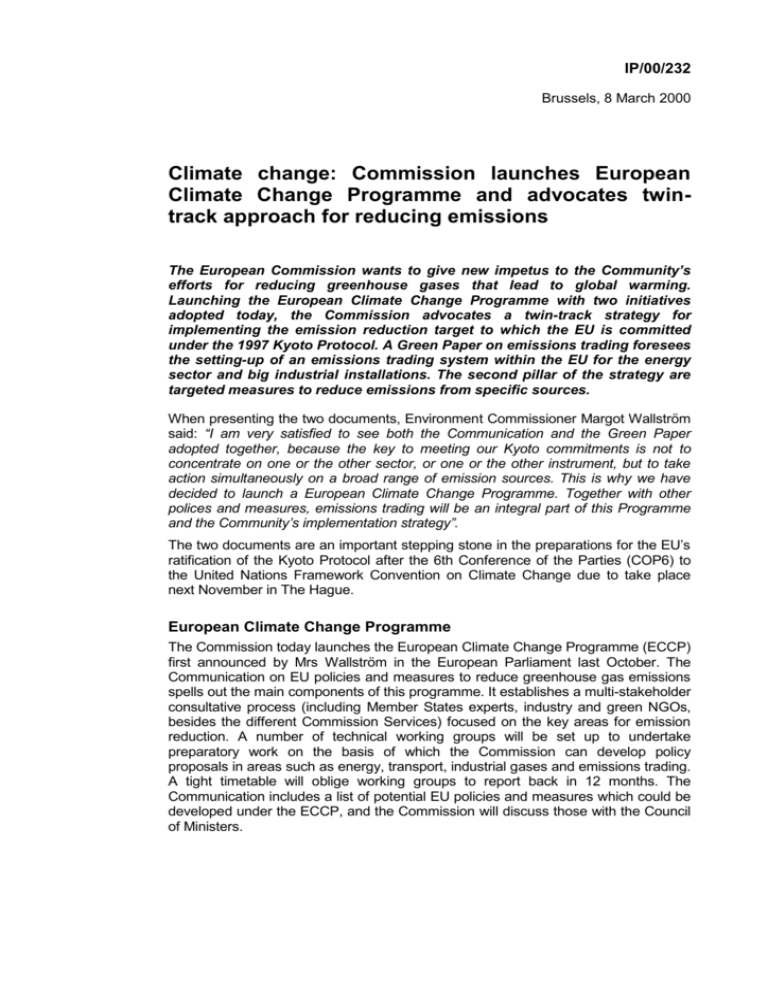
IP/00/232 Brussels, 8 March 2000 Climate change: Commission launches European Climate Change Programme and advocates twintrack approach for reducing emissions The European Commission wants to give new impetus to the Community’s efforts for reducing greenhouse gases that lead to global warming. Launching the European Climate Change Programme with two initiatives adopted today, the Commission advocates a twin-track strategy for implementing the emission reduction target to which the EU is committed under the 1997 Kyoto Protocol. A Green Paper on emissions trading foresees the setting-up of an emissions trading system within the EU for the energy sector and big industrial installations. The second pillar of the strategy are targeted measures to reduce emissions from specific sources. When presenting the two documents, Environment Commissioner Margot Wallström said: “I am very satisfied to see both the Communication and the Green Paper adopted together, because the key to meeting our Kyoto commitments is not to concentrate on one or the other sector, or one or the other instrument, but to take action simultaneously on a broad range of emission sources. This is why we have decided to launch a European Climate Change Programme. Together with other polices and measures, emissions trading will be an integral part of this Programme and the Community’s implementation strategy”. The two documents are an important stepping stone in the preparations for the EU’s ratification of the Kyoto Protocol after the 6th Conference of the Parties (COP6) to the United Nations Framework Convention on Climate Change due to take place next November in The Hague. European Climate Change Programme The Commission today launches the European Climate Change Programme (ECCP) first announced by Mrs Wallström in the European Parliament last October. The Communication on EU policies and measures to reduce greenhouse gas emissions spells out the main components of this programme. It establishes a multi-stakeholder consultative process (including Member States experts, industry and green NGOs, besides the different Commission Services) focused on the key areas for emission reduction. A number of technical working groups will be set up to undertake preparatory work on the basis of which the Commission can develop policy proposals in areas such as energy, transport, industrial gases and emissions trading. A tight timetable will oblige working groups to report back in 12 months. The Communication includes a list of potential EU policies and measures which could be developed under the ECCP, and the Commission will discuss those with the Council of Ministers. The Commission underlines, as on earlier occasions, that much more effort is needed for the EU to meet its Kyoto target of reducing greenhouse gas emissions by 8% in the timeframe 2008/2012 as compared to 1990. The latest data show that CO2 emissions are increasing rather than decreasing, and that the 8% reduction objective will not be met if no additional measures are taken. This emphasises the need for a reinforcement of policies and measures to reduce emissions across all sectors of the EU’s economy. “The picture is not rosy. We have to put into place additional measures at the Community level if we are to achieve what we promised in Kyoto. At the same time, the Member States should not rely on the Community doing it all. Most of them are not on track for reaching their national targets”, warned Margot Wallström. Emissions trading One pillar of the Community’s climate change strategy will be an internal EU greenhouse gas emissions trading scheme. It falls under the European Climate Change Programme and the Commission has now adopted a Green Paper to improve understanding of emissions trading as a potential tool for climate change policy within the EU. The Green Paper emphasises the Community dimension to emissions trading in terms of for example the internal market and competition, which is often over-looked when considering its role within the Community. This is all the more important in view of the decisions being taken within the next 12 months or so by the Member States on their national implementation strategies, in preparation for ratifying the Kyoto Protocol. The Green Paper fulfils both an “informative” role, in explaining a much misunderstood instrument, and an “analytical” role, in making a strong case for Community involvement in future developments in this area. However, as befits a Green Paper, a number of options are explored without firm conclusions being drawn. To facilitate the consultation exercise being launched, a number of questions are asked. Interested parties are invited to react within 6 months, so that the Commission can consider the views of all stakeholders before proceeding further. Acknowledging the considerable interest in emissions trading in the climate change debate, Commissioner Wallström insisted that: “The Green Paper rightly advocates a prudent commencement of emissions trading that, if successful, can be extended. It must be understood that we are breaking new ground with such a system and we need to get it right from the start. However, I am firmly convinced that it can work if we put into place a strong framework with adequate controls. Then emissions trading will ensure that emission reductions will be made where they are cheapest and hence we will all benefit economically. It’s not just about leaving things to market forces, but creating the necessary structures in which cost-effective incentives can exist”. 2









